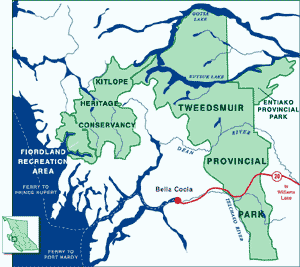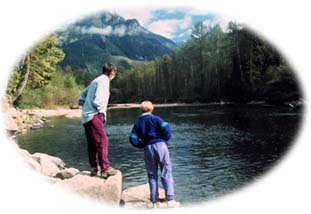|
|
 |
|
|
|
Sailing into the Kitlope Estuary, the access point to one of the last great coastal wildernesses on earth, one is struck by the overwhelming beauty of the place. Towering peaks, granite cliffs, glaciers, and waterfalls greet visitors as they have the native Haisla for centuries.
At 317,000 hectares (780,000 acres) the Kitlope preserves one of the largest remaining intact coastal temperate rainforests in the world. For a description of the life of a tree in this ecosystem, check out Centuries In The Life Of A Great Cedar.
Unlike many parks that protect only part of an ecosystem, the Kitlope is a complete watershed from its glacier peaks to the ocean floor. Using the conservation biology principles of connectivity, this park was adjoined to Tweedsmuir Park to create an even larger wildlife preserve.
|
"Towering peaks, granite cliffs, glaciers, and waterfalls greet visitors as they have the native Haisla for centuries."
|

The Kitlope Valley is in an isolated region of northwestern BC, south of Kitimat, on BC's rainforest coast. One must arrive by boat, sailing or motoring from the ocean into the Gardner Canal, and then anchoring in the Kitlope River estuary, just outside the park. Some visitors travel up BC's central coast before reaching this destination, while others fly directly to Kitamaat Village, or the town of Kitimat, and arrange boat transportation from there.
|

Click on the map to view an enlargement
|

The wildlife of the Kitlope has attracted researchers from around the world. This complete ecosystem provides important habitat for moose, mountain goat, and black bear. It is of special importance to the endangered grizzly bear since they require huge ranges, and have lost so much of their traditional habitat elsewhere in BC to clearcutting. Unlike many other protected areas, the Kitlope is of sufficient size to accommodate a grizzly's needs from birth to death.
Hundreds of species of birds, including peregrine falcons and endangered marbled murrelets, make the Kitlope their home. Bald eagles feed on the six species of Pacific salmon that return to spawn every year, or on trout and oolichan found in the conservancy's lakes.
|
"At 317,000 hectares (800,000 acres) the Kitlope conserves one of the largest remaining coastal temperate rainforests in the world."
|

The Kitlope is a remote coastal wilderness. There are no campsites or facilities, and the access is by boat only. But this is part of the pleasure of the place. To sail up the fjord of the Gardner Canal is a breathtaking experience. A kayak is needed to travel up the Kitlope River towards Kitlope Lake. This seven mile long lake in the heart of the park features beautiful sandy beaches, and stunning views of thousand year old trees and glacier capped mountains. It is an excellent place to spend time boating, nature viewing, fishing, and wilderness hiking. Kitlope Lake is also home to the 'Rediscovery Camp' run by the Haisla First Nation to educate their youth in the Haisla cultural heritage.
|
"Unlike many other protected areas, the Kitlope is of sufficient size to accommodate a grizzly's needs from birth to death."
|

The Kitlope is one of the few intact coastal valleys that has essentially escaped the devastation of clearcutting. In 1988 the West Fraser Timber Company was planning to log the Kitlope Valley in order to supply wood for their Skeena Sawmills operation in Terrace. This was opposed strongly by the Haisla First Nation who held firm against attempts by the company to overcome their opposition by offering jobs and other incentives.
The Portland based Ecotrust conservation organization joined with the Haisla, launching the campaign to have the area remain intact. Their campaign was later joined by several other environmental groups, including the Valhalla Wilderness Society, Sierra Club of Western Canada, and the Western Canada Wilderness Committee.
In 1994, West Fraser Timber Co. voluntarily relinquished its timber rights, without calling for compensation. On August 16, 1994, the BC provincial government announced the conservation of the region as a Provincial Heritage Conservancy, to be co-managed by the Haisla First Nation.
Ecotrust has continued to work with the Haisla to develop the Nanakila Institute, an organization that provides conservation training to the Haisla, and to assists them in forming conservation-based, economic development projects such as ecotourism companies.
|
|
Return to the Rainforest Coast Region
Become Involved!
|
|

